Business Environment Analysis Report - Business Strategy Analysis
VerifiedAdded on 2020/06/05
|11
|3746
|123
Report
AI Summary
This report provides a comprehensive analysis of business environment, focusing on strategic planning and various analytical tools. It begins with an introduction to business strategy and its importance, followed by an in-depth examination of analytical techniques such as BCG matrix, SWOT analysis, and value chain analysis. The report explores both internal and external factors influencing organizational environment, including decision-makers, resources, competition, and stakeholders. The discussion covers the application of PESTLE analysis and Porter's Diamond Model. The document concludes with a reflection on the learning process and offers recommendations for effective business strategy implementation, emphasizing the importance of aligning business goals with the business model. The report is designed to provide insights into strategic planning, business environment analysis, and the utilization of various tools.
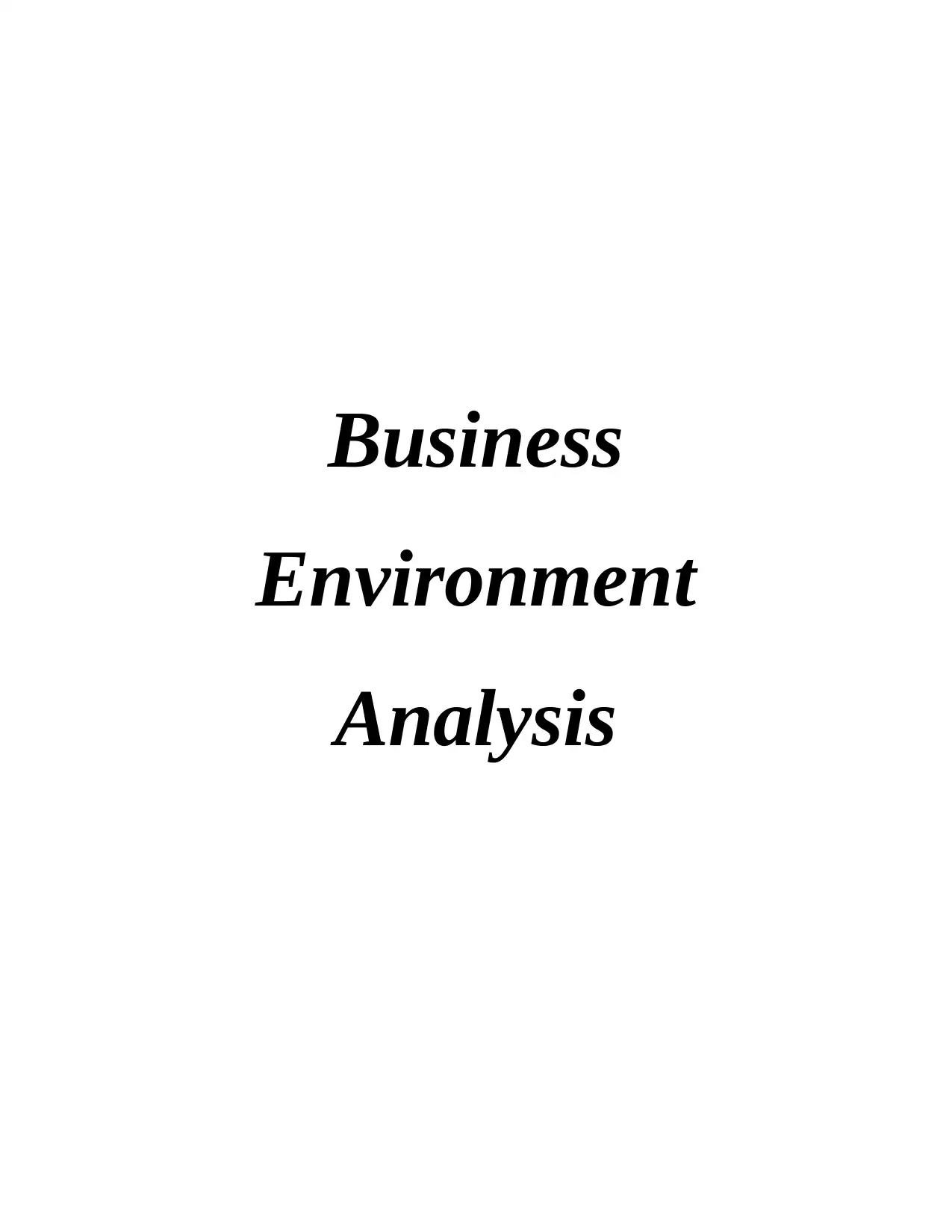
Business
Environment
Analysis
Environment
Analysis
Paraphrase This Document
Need a fresh take? Get an instant paraphrase of this document with our AI Paraphraser
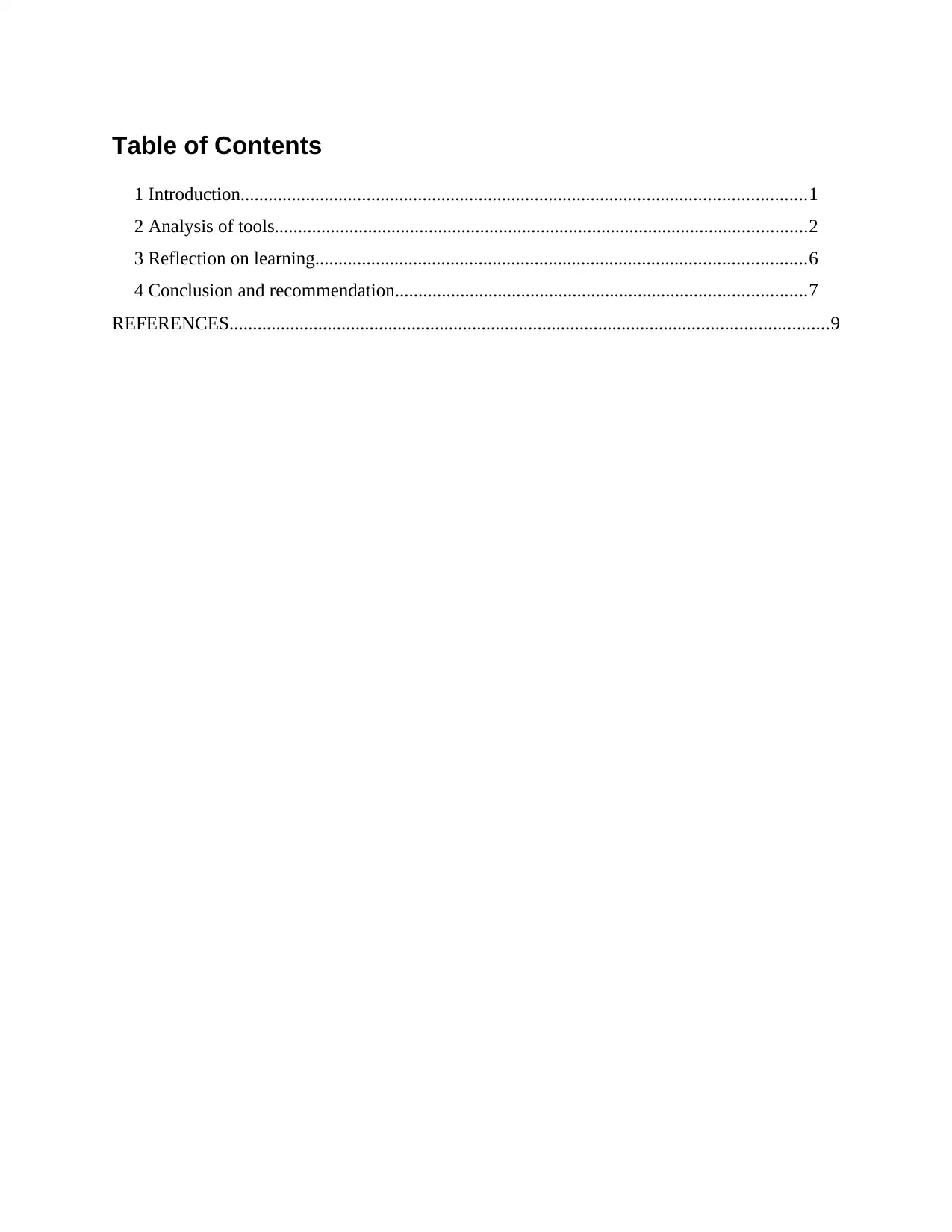
Table of Contents
1 Introduction.........................................................................................................................1
2 Analysis of tools..................................................................................................................2
3 Reflection on learning.........................................................................................................6
4 Conclusion and recommendation........................................................................................7
REFERENCES................................................................................................................................9
1 Introduction.........................................................................................................................1
2 Analysis of tools..................................................................................................................2
3 Reflection on learning.........................................................................................................6
4 Conclusion and recommendation........................................................................................7
REFERENCES................................................................................................................................9
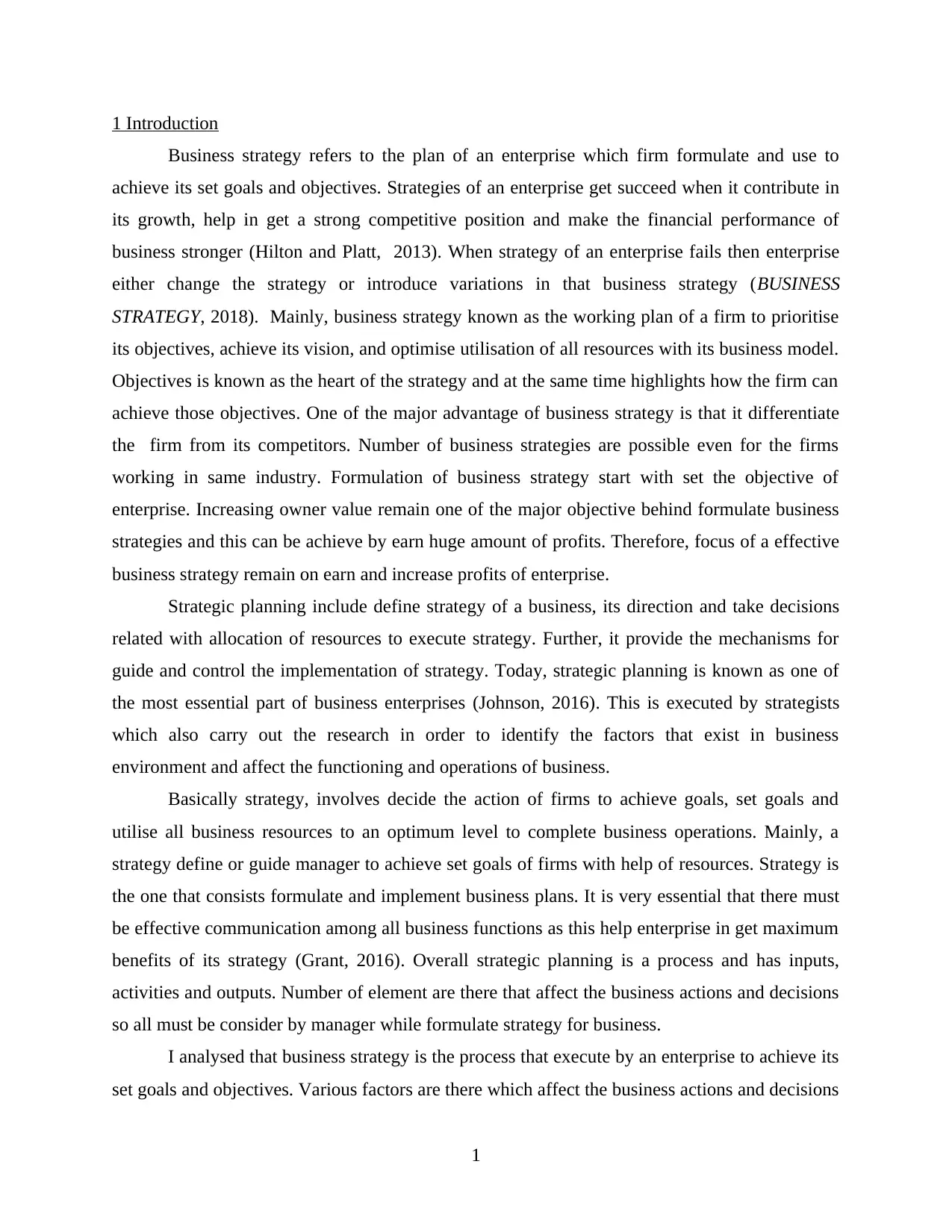
1 Introduction
Business strategy refers to the plan of an enterprise which firm formulate and use to
achieve its set goals and objectives. Strategies of an enterprise get succeed when it contribute in
its growth, help in get a strong competitive position and make the financial performance of
business stronger (Hilton and Platt, 2013). When strategy of an enterprise fails then enterprise
either change the strategy or introduce variations in that business strategy (BUSINESS
STRATEGY, 2018). Mainly, business strategy known as the working plan of a firm to prioritise
its objectives, achieve its vision, and optimise utilisation of all resources with its business model.
Objectives is known as the heart of the strategy and at the same time highlights how the firm can
achieve those objectives. One of the major advantage of business strategy is that it differentiate
the firm from its competitors. Number of business strategies are possible even for the firms
working in same industry. Formulation of business strategy start with set the objective of
enterprise. Increasing owner value remain one of the major objective behind formulate business
strategies and this can be achieve by earn huge amount of profits. Therefore, focus of a effective
business strategy remain on earn and increase profits of enterprise.
Strategic planning include define strategy of a business, its direction and take decisions
related with allocation of resources to execute strategy. Further, it provide the mechanisms for
guide and control the implementation of strategy. Today, strategic planning is known as one of
the most essential part of business enterprises (Johnson, 2016). This is executed by strategists
which also carry out the research in order to identify the factors that exist in business
environment and affect the functioning and operations of business.
Basically strategy, involves decide the action of firms to achieve goals, set goals and
utilise all business resources to an optimum level to complete business operations. Mainly, a
strategy define or guide manager to achieve set goals of firms with help of resources. Strategy is
the one that consists formulate and implement business plans. It is very essential that there must
be effective communication among all business functions as this help enterprise in get maximum
benefits of its strategy (Grant, 2016). Overall strategic planning is a process and has inputs,
activities and outputs. Number of element are there that affect the business actions and decisions
so all must be consider by manager while formulate strategy for business.
I analysed that business strategy is the process that execute by an enterprise to achieve its
set goals and objectives. Various factors are there which affect the business actions and decisions
1
Business strategy refers to the plan of an enterprise which firm formulate and use to
achieve its set goals and objectives. Strategies of an enterprise get succeed when it contribute in
its growth, help in get a strong competitive position and make the financial performance of
business stronger (Hilton and Platt, 2013). When strategy of an enterprise fails then enterprise
either change the strategy or introduce variations in that business strategy (BUSINESS
STRATEGY, 2018). Mainly, business strategy known as the working plan of a firm to prioritise
its objectives, achieve its vision, and optimise utilisation of all resources with its business model.
Objectives is known as the heart of the strategy and at the same time highlights how the firm can
achieve those objectives. One of the major advantage of business strategy is that it differentiate
the firm from its competitors. Number of business strategies are possible even for the firms
working in same industry. Formulation of business strategy start with set the objective of
enterprise. Increasing owner value remain one of the major objective behind formulate business
strategies and this can be achieve by earn huge amount of profits. Therefore, focus of a effective
business strategy remain on earn and increase profits of enterprise.
Strategic planning include define strategy of a business, its direction and take decisions
related with allocation of resources to execute strategy. Further, it provide the mechanisms for
guide and control the implementation of strategy. Today, strategic planning is known as one of
the most essential part of business enterprises (Johnson, 2016). This is executed by strategists
which also carry out the research in order to identify the factors that exist in business
environment and affect the functioning and operations of business.
Basically strategy, involves decide the action of firms to achieve goals, set goals and
utilise all business resources to an optimum level to complete business operations. Mainly, a
strategy define or guide manager to achieve set goals of firms with help of resources. Strategy is
the one that consists formulate and implement business plans. It is very essential that there must
be effective communication among all business functions as this help enterprise in get maximum
benefits of its strategy (Grant, 2016). Overall strategic planning is a process and has inputs,
activities and outputs. Number of element are there that affect the business actions and decisions
so all must be consider by manager while formulate strategy for business.
I analysed that business strategy is the process that execute by an enterprise to achieve its
set goals and objectives. Various factors are there which affect the business actions and decisions
1
⊘ This is a preview!⊘
Do you want full access?
Subscribe today to unlock all pages.

Trusted by 1+ million students worldwide
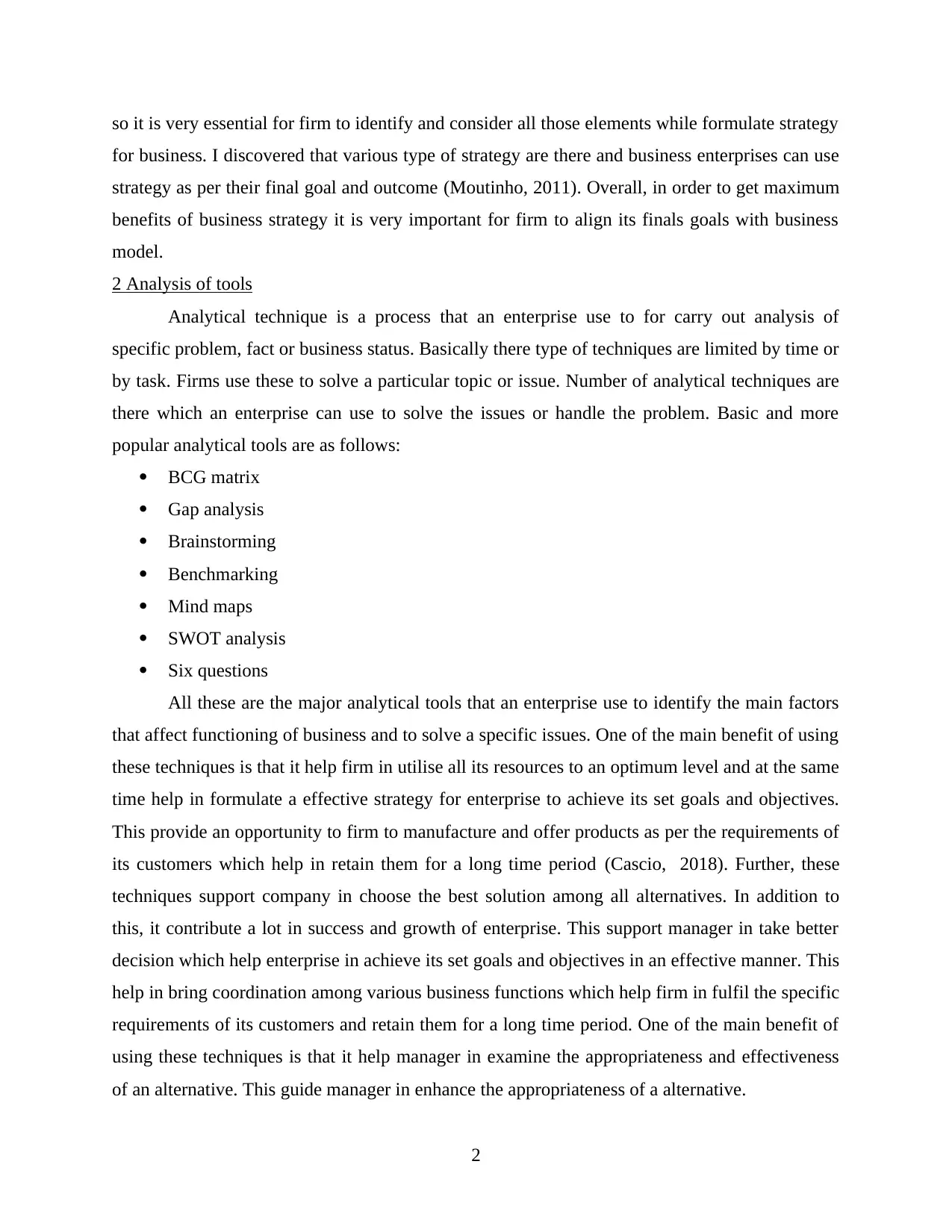
so it is very essential for firm to identify and consider all those elements while formulate strategy
for business. I discovered that various type of strategy are there and business enterprises can use
strategy as per their final goal and outcome (Moutinho, 2011). Overall, in order to get maximum
benefits of business strategy it is very important for firm to align its finals goals with business
model.
2 Analysis of tools
Analytical technique is a process that an enterprise use to for carry out analysis of
specific problem, fact or business status. Basically there type of techniques are limited by time or
by task. Firms use these to solve a particular topic or issue. Number of analytical techniques are
there which an enterprise can use to solve the issues or handle the problem. Basic and more
popular analytical tools are as follows:
BCG matrix
Gap analysis
Brainstorming
Benchmarking
Mind maps
SWOT analysis
Six questions
All these are the major analytical tools that an enterprise use to identify the main factors
that affect functioning of business and to solve a specific issues. One of the main benefit of using
these techniques is that it help firm in utilise all its resources to an optimum level and at the same
time help in formulate a effective strategy for enterprise to achieve its set goals and objectives.
This provide an opportunity to firm to manufacture and offer products as per the requirements of
its customers which help in retain them for a long time period (Cascio, 2018). Further, these
techniques support company in choose the best solution among all alternatives. In addition to
this, it contribute a lot in success and growth of enterprise. This support manager in take better
decision which help enterprise in achieve its set goals and objectives in an effective manner. This
help in bring coordination among various business functions which help firm in fulfil the specific
requirements of its customers and retain them for a long time period. One of the main benefit of
using these techniques is that it help manager in examine the appropriateness and effectiveness
of an alternative. This guide manager in enhance the appropriateness of a alternative.
2
for business. I discovered that various type of strategy are there and business enterprises can use
strategy as per their final goal and outcome (Moutinho, 2011). Overall, in order to get maximum
benefits of business strategy it is very important for firm to align its finals goals with business
model.
2 Analysis of tools
Analytical technique is a process that an enterprise use to for carry out analysis of
specific problem, fact or business status. Basically there type of techniques are limited by time or
by task. Firms use these to solve a particular topic or issue. Number of analytical techniques are
there which an enterprise can use to solve the issues or handle the problem. Basic and more
popular analytical tools are as follows:
BCG matrix
Gap analysis
Brainstorming
Benchmarking
Mind maps
SWOT analysis
Six questions
All these are the major analytical tools that an enterprise use to identify the main factors
that affect functioning of business and to solve a specific issues. One of the main benefit of using
these techniques is that it help firm in utilise all its resources to an optimum level and at the same
time help in formulate a effective strategy for enterprise to achieve its set goals and objectives.
This provide an opportunity to firm to manufacture and offer products as per the requirements of
its customers which help in retain them for a long time period (Cascio, 2018). Further, these
techniques support company in choose the best solution among all alternatives. In addition to
this, it contribute a lot in success and growth of enterprise. This support manager in take better
decision which help enterprise in achieve its set goals and objectives in an effective manner. This
help in bring coordination among various business functions which help firm in fulfil the specific
requirements of its customers and retain them for a long time period. One of the main benefit of
using these techniques is that it help manager in examine the appropriateness and effectiveness
of an alternative. This guide manager in enhance the appropriateness of a alternative.
2
Paraphrase This Document
Need a fresh take? Get an instant paraphrase of this document with our AI Paraphraser
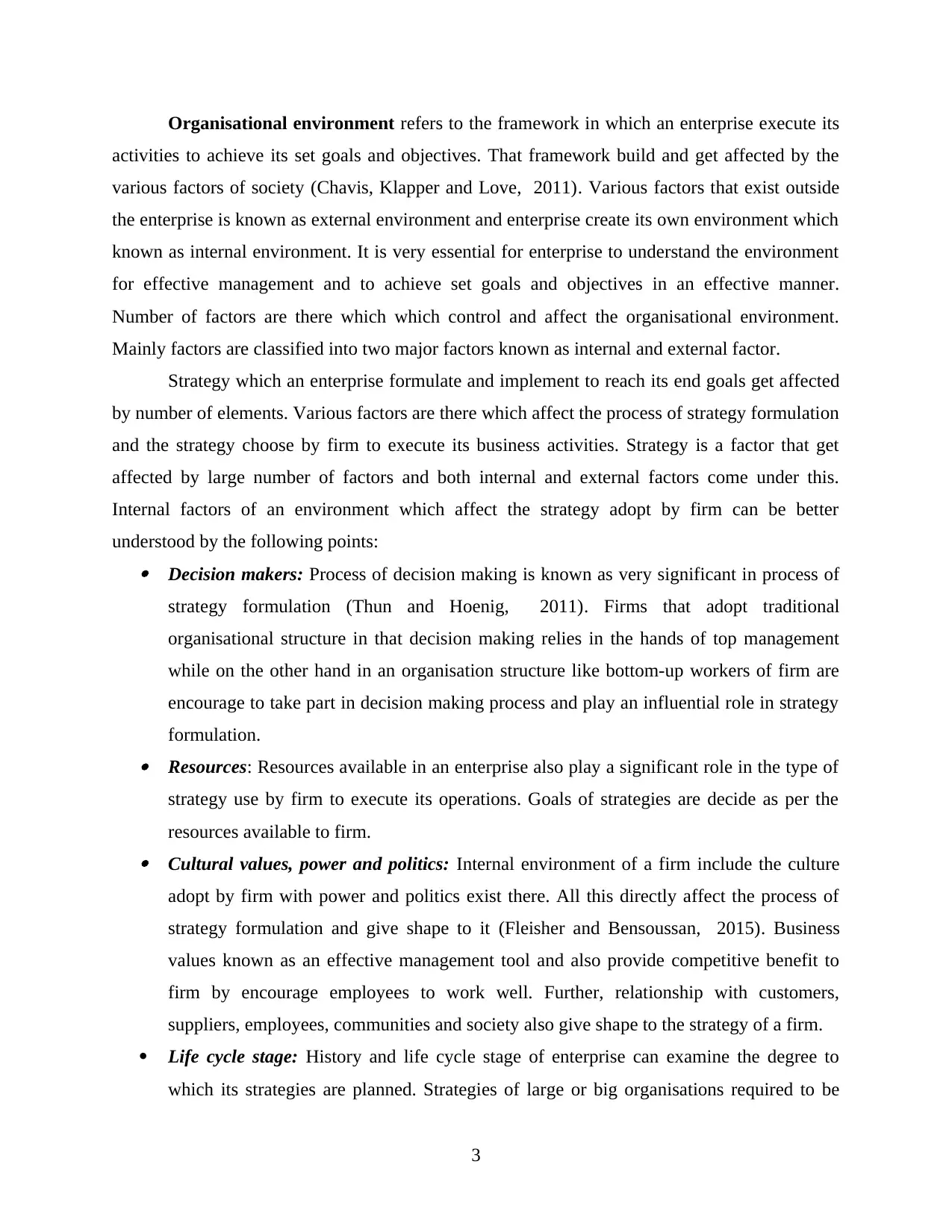
Organisational environment refers to the framework in which an enterprise execute its
activities to achieve its set goals and objectives. That framework build and get affected by the
various factors of society (Chavis, Klapper and Love, 2011). Various factors that exist outside
the enterprise is known as external environment and enterprise create its own environment which
known as internal environment. It is very essential for enterprise to understand the environment
for effective management and to achieve set goals and objectives in an effective manner.
Number of factors are there which which control and affect the organisational environment.
Mainly factors are classified into two major factors known as internal and external factor.
Strategy which an enterprise formulate and implement to reach its end goals get affected
by number of elements. Various factors are there which affect the process of strategy formulation
and the strategy choose by firm to execute its business activities. Strategy is a factor that get
affected by large number of factors and both internal and external factors come under this.
Internal factors of an environment which affect the strategy adopt by firm can be better
understood by the following points: Decision makers: Process of decision making is known as very significant in process of
strategy formulation (Thun and Hoenig, 2011). Firms that adopt traditional
organisational structure in that decision making relies in the hands of top management
while on the other hand in an organisation structure like bottom-up workers of firm are
encourage to take part in decision making process and play an influential role in strategy
formulation. Resources: Resources available in an enterprise also play a significant role in the type of
strategy use by firm to execute its operations. Goals of strategies are decide as per the
resources available to firm. Cultural values, power and politics: Internal environment of a firm include the culture
adopt by firm with power and politics exist there. All this directly affect the process of
strategy formulation and give shape to it (Fleisher and Bensoussan, 2015). Business
values known as an effective management tool and also provide competitive benefit to
firm by encourage employees to work well. Further, relationship with customers,
suppliers, employees, communities and society also give shape to the strategy of a firm.
Life cycle stage: History and life cycle stage of enterprise can examine the degree to
which its strategies are planned. Strategies of large or big organisations required to be
3
activities to achieve its set goals and objectives. That framework build and get affected by the
various factors of society (Chavis, Klapper and Love, 2011). Various factors that exist outside
the enterprise is known as external environment and enterprise create its own environment which
known as internal environment. It is very essential for enterprise to understand the environment
for effective management and to achieve set goals and objectives in an effective manner.
Number of factors are there which which control and affect the organisational environment.
Mainly factors are classified into two major factors known as internal and external factor.
Strategy which an enterprise formulate and implement to reach its end goals get affected
by number of elements. Various factors are there which affect the process of strategy formulation
and the strategy choose by firm to execute its business activities. Strategy is a factor that get
affected by large number of factors and both internal and external factors come under this.
Internal factors of an environment which affect the strategy adopt by firm can be better
understood by the following points: Decision makers: Process of decision making is known as very significant in process of
strategy formulation (Thun and Hoenig, 2011). Firms that adopt traditional
organisational structure in that decision making relies in the hands of top management
while on the other hand in an organisation structure like bottom-up workers of firm are
encourage to take part in decision making process and play an influential role in strategy
formulation. Resources: Resources available in an enterprise also play a significant role in the type of
strategy use by firm to execute its operations. Goals of strategies are decide as per the
resources available to firm. Cultural values, power and politics: Internal environment of a firm include the culture
adopt by firm with power and politics exist there. All this directly affect the process of
strategy formulation and give shape to it (Fleisher and Bensoussan, 2015). Business
values known as an effective management tool and also provide competitive benefit to
firm by encourage employees to work well. Further, relationship with customers,
suppliers, employees, communities and society also give shape to the strategy of a firm.
Life cycle stage: History and life cycle stage of enterprise can examine the degree to
which its strategies are planned. Strategies of large or big organisations required to be
3
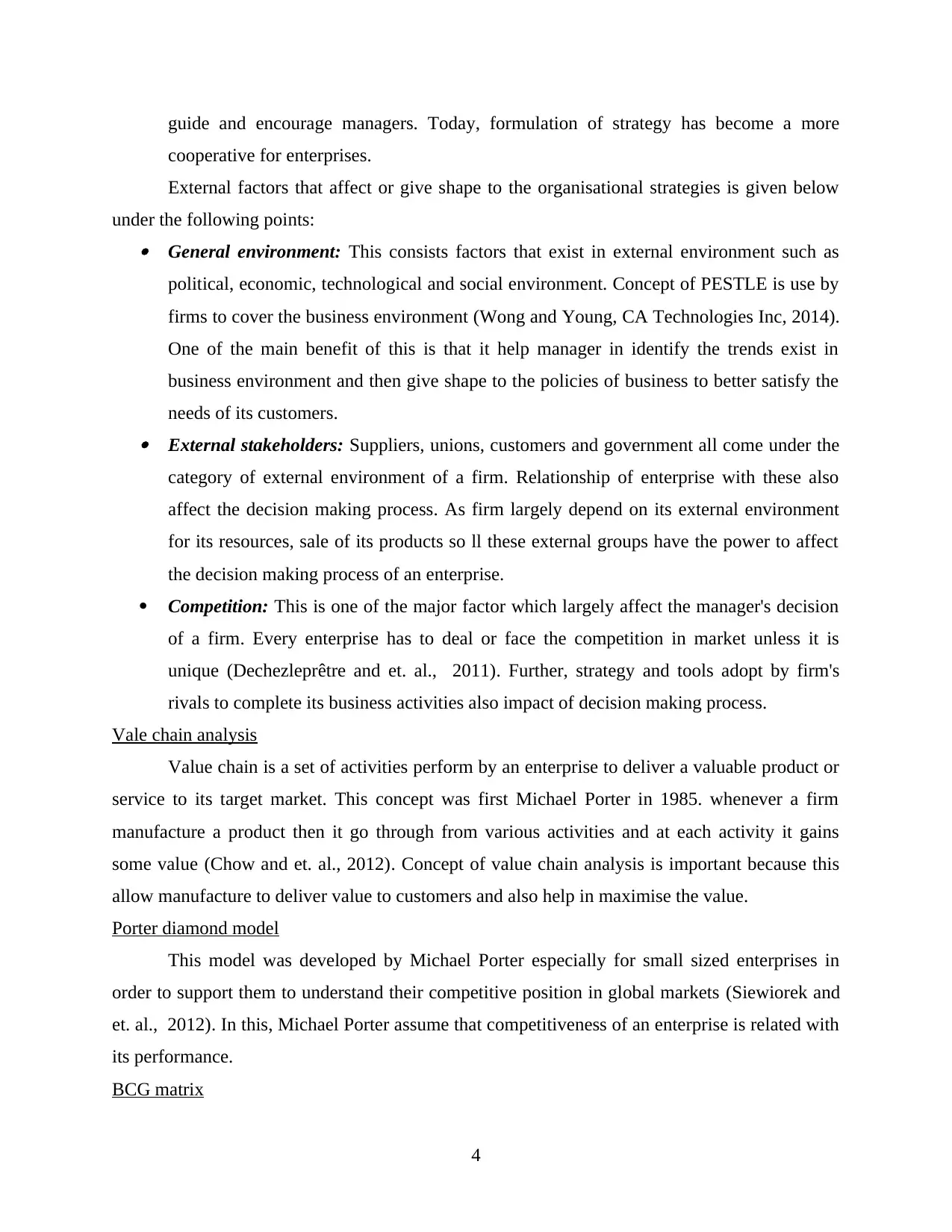
guide and encourage managers. Today, formulation of strategy has become a more
cooperative for enterprises.
External factors that affect or give shape to the organisational strategies is given below
under the following points: General environment: This consists factors that exist in external environment such as
political, economic, technological and social environment. Concept of PESTLE is use by
firms to cover the business environment (Wong and Young, CA Technologies Inc, 2014).
One of the main benefit of this is that it help manager in identify the trends exist in
business environment and then give shape to the policies of business to better satisfy the
needs of its customers. External stakeholders: Suppliers, unions, customers and government all come under the
category of external environment of a firm. Relationship of enterprise with these also
affect the decision making process. As firm largely depend on its external environment
for its resources, sale of its products so ll these external groups have the power to affect
the decision making process of an enterprise.
Competition: This is one of the major factor which largely affect the manager's decision
of a firm. Every enterprise has to deal or face the competition in market unless it is
unique (Dechezleprêtre and et. al., 2011). Further, strategy and tools adopt by firm's
rivals to complete its business activities also impact of decision making process.
Vale chain analysis
Value chain is a set of activities perform by an enterprise to deliver a valuable product or
service to its target market. This concept was first Michael Porter in 1985. whenever a firm
manufacture a product then it go through from various activities and at each activity it gains
some value (Chow and et. al., 2012). Concept of value chain analysis is important because this
allow manufacture to deliver value to customers and also help in maximise the value.
Porter diamond model
This model was developed by Michael Porter especially for small sized enterprises in
order to support them to understand their competitive position in global markets (Siewiorek and
et. al., 2012). In this, Michael Porter assume that competitiveness of an enterprise is related with
its performance.
BCG matrix
4
cooperative for enterprises.
External factors that affect or give shape to the organisational strategies is given below
under the following points: General environment: This consists factors that exist in external environment such as
political, economic, technological and social environment. Concept of PESTLE is use by
firms to cover the business environment (Wong and Young, CA Technologies Inc, 2014).
One of the main benefit of this is that it help manager in identify the trends exist in
business environment and then give shape to the policies of business to better satisfy the
needs of its customers. External stakeholders: Suppliers, unions, customers and government all come under the
category of external environment of a firm. Relationship of enterprise with these also
affect the decision making process. As firm largely depend on its external environment
for its resources, sale of its products so ll these external groups have the power to affect
the decision making process of an enterprise.
Competition: This is one of the major factor which largely affect the manager's decision
of a firm. Every enterprise has to deal or face the competition in market unless it is
unique (Dechezleprêtre and et. al., 2011). Further, strategy and tools adopt by firm's
rivals to complete its business activities also impact of decision making process.
Vale chain analysis
Value chain is a set of activities perform by an enterprise to deliver a valuable product or
service to its target market. This concept was first Michael Porter in 1985. whenever a firm
manufacture a product then it go through from various activities and at each activity it gains
some value (Chow and et. al., 2012). Concept of value chain analysis is important because this
allow manufacture to deliver value to customers and also help in maximise the value.
Porter diamond model
This model was developed by Michael Porter especially for small sized enterprises in
order to support them to understand their competitive position in global markets (Siewiorek and
et. al., 2012). In this, Michael Porter assume that competitiveness of an enterprise is related with
its performance.
BCG matrix
4
⊘ This is a preview!⊘
Do you want full access?
Subscribe today to unlock all pages.

Trusted by 1+ million students worldwide
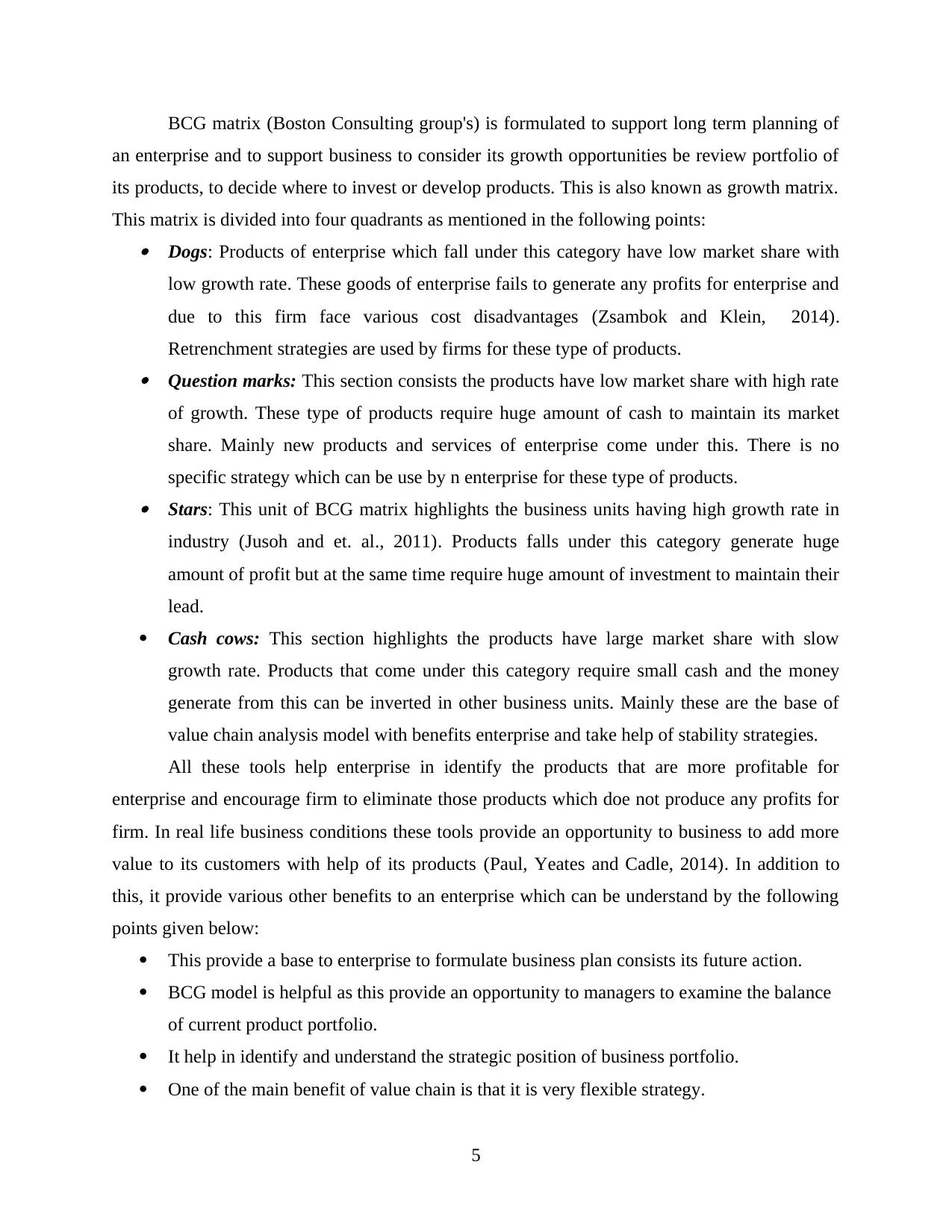
BCG matrix (Boston Consulting group's) is formulated to support long term planning of
an enterprise and to support business to consider its growth opportunities be review portfolio of
its products, to decide where to invest or develop products. This is also known as growth matrix.
This matrix is divided into four quadrants as mentioned in the following points: Dogs: Products of enterprise which fall under this category have low market share with
low growth rate. These goods of enterprise fails to generate any profits for enterprise and
due to this firm face various cost disadvantages (Zsambok and Klein, 2014).
Retrenchment strategies are used by firms for these type of products. Question marks: This section consists the products have low market share with high rate
of growth. These type of products require huge amount of cash to maintain its market
share. Mainly new products and services of enterprise come under this. There is no
specific strategy which can be use by n enterprise for these type of products. Stars: This unit of BCG matrix highlights the business units having high growth rate in
industry (Jusoh and et. al., 2011). Products falls under this category generate huge
amount of profit but at the same time require huge amount of investment to maintain their
lead.
Cash cows: This section highlights the products have large market share with slow
growth rate. Products that come under this category require small cash and the money
generate from this can be inverted in other business units. Mainly these are the base of
value chain analysis model with benefits enterprise and take help of stability strategies.
All these tools help enterprise in identify the products that are more profitable for
enterprise and encourage firm to eliminate those products which doe not produce any profits for
firm. In real life business conditions these tools provide an opportunity to business to add more
value to its customers with help of its products (Paul, Yeates and Cadle, 2014). In addition to
this, it provide various other benefits to an enterprise which can be understand by the following
points given below:
This provide a base to enterprise to formulate business plan consists its future action.
BCG model is helpful as this provide an opportunity to managers to examine the balance
of current product portfolio.
It help in identify and understand the strategic position of business portfolio.
One of the main benefit of value chain is that it is very flexible strategy.
5
an enterprise and to support business to consider its growth opportunities be review portfolio of
its products, to decide where to invest or develop products. This is also known as growth matrix.
This matrix is divided into four quadrants as mentioned in the following points: Dogs: Products of enterprise which fall under this category have low market share with
low growth rate. These goods of enterprise fails to generate any profits for enterprise and
due to this firm face various cost disadvantages (Zsambok and Klein, 2014).
Retrenchment strategies are used by firms for these type of products. Question marks: This section consists the products have low market share with high rate
of growth. These type of products require huge amount of cash to maintain its market
share. Mainly new products and services of enterprise come under this. There is no
specific strategy which can be use by n enterprise for these type of products. Stars: This unit of BCG matrix highlights the business units having high growth rate in
industry (Jusoh and et. al., 2011). Products falls under this category generate huge
amount of profit but at the same time require huge amount of investment to maintain their
lead.
Cash cows: This section highlights the products have large market share with slow
growth rate. Products that come under this category require small cash and the money
generate from this can be inverted in other business units. Mainly these are the base of
value chain analysis model with benefits enterprise and take help of stability strategies.
All these tools help enterprise in identify the products that are more profitable for
enterprise and encourage firm to eliminate those products which doe not produce any profits for
firm. In real life business conditions these tools provide an opportunity to business to add more
value to its customers with help of its products (Paul, Yeates and Cadle, 2014). In addition to
this, it provide various other benefits to an enterprise which can be understand by the following
points given below:
This provide a base to enterprise to formulate business plan consists its future action.
BCG model is helpful as this provide an opportunity to managers to examine the balance
of current product portfolio.
It help in identify and understand the strategic position of business portfolio.
One of the main benefit of value chain is that it is very flexible strategy.
5
Paraphrase This Document
Need a fresh take? Get an instant paraphrase of this document with our AI Paraphraser
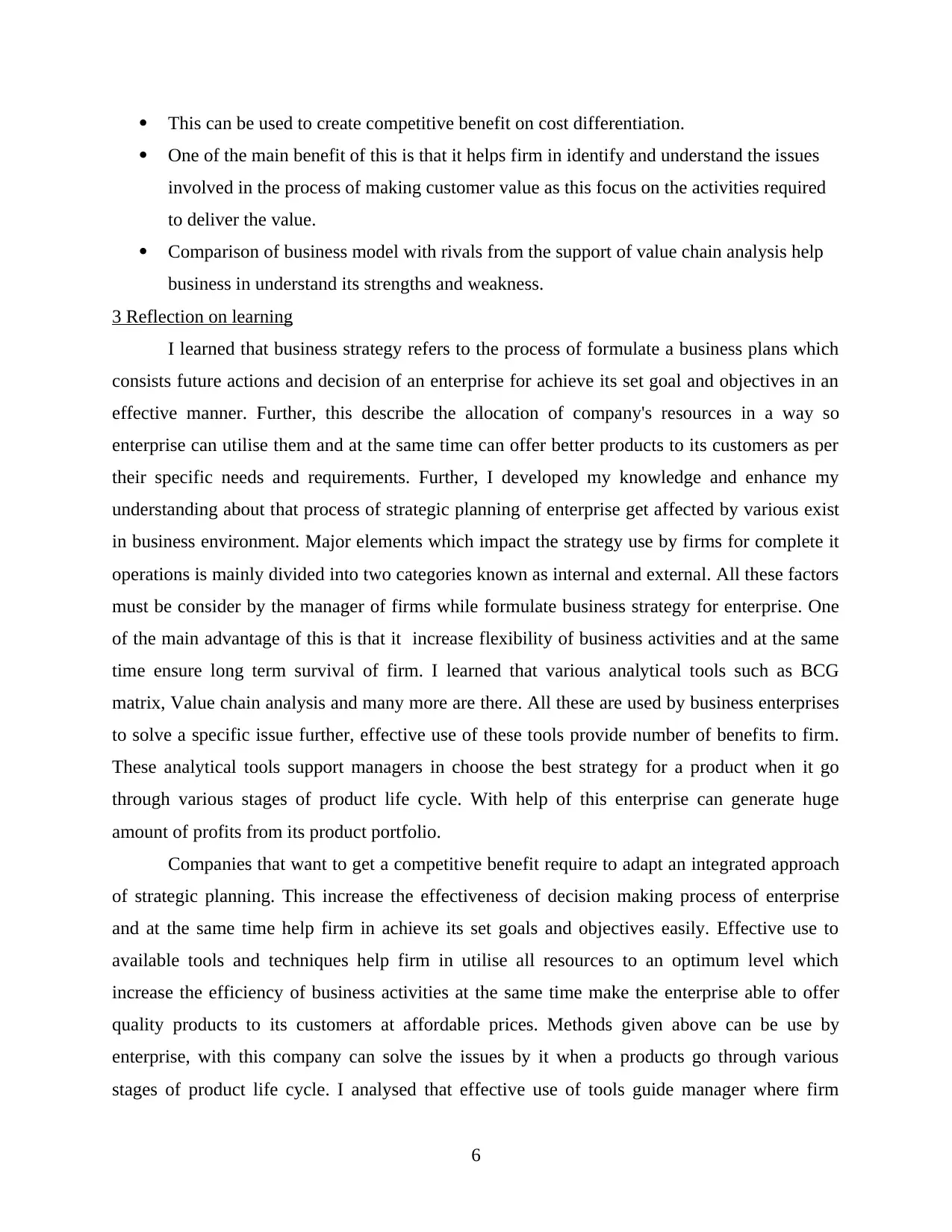
This can be used to create competitive benefit on cost differentiation.
One of the main benefit of this is that it helps firm in identify and understand the issues
involved in the process of making customer value as this focus on the activities required
to deliver the value.
Comparison of business model with rivals from the support of value chain analysis help
business in understand its strengths and weakness.
3 Reflection on learning
I learned that business strategy refers to the process of formulate a business plans which
consists future actions and decision of an enterprise for achieve its set goal and objectives in an
effective manner. Further, this describe the allocation of company's resources in a way so
enterprise can utilise them and at the same time can offer better products to its customers as per
their specific needs and requirements. Further, I developed my knowledge and enhance my
understanding about that process of strategic planning of enterprise get affected by various exist
in business environment. Major elements which impact the strategy use by firms for complete it
operations is mainly divided into two categories known as internal and external. All these factors
must be consider by the manager of firms while formulate business strategy for enterprise. One
of the main advantage of this is that it increase flexibility of business activities and at the same
time ensure long term survival of firm. I learned that various analytical tools such as BCG
matrix, Value chain analysis and many more are there. All these are used by business enterprises
to solve a specific issue further, effective use of these tools provide number of benefits to firm.
These analytical tools support managers in choose the best strategy for a product when it go
through various stages of product life cycle. With help of this enterprise can generate huge
amount of profits from its product portfolio.
Companies that want to get a competitive benefit require to adapt an integrated approach
of strategic planning. This increase the effectiveness of decision making process of enterprise
and at the same time help firm in achieve its set goals and objectives easily. Effective use to
available tools and techniques help firm in utilise all resources to an optimum level which
increase the efficiency of business activities at the same time make the enterprise able to offer
quality products to its customers at affordable prices. Methods given above can be use by
enterprise, with this company can solve the issues by it when a products go through various
stages of product life cycle. I analysed that effective use of tools guide manager where firm
6
One of the main benefit of this is that it helps firm in identify and understand the issues
involved in the process of making customer value as this focus on the activities required
to deliver the value.
Comparison of business model with rivals from the support of value chain analysis help
business in understand its strengths and weakness.
3 Reflection on learning
I learned that business strategy refers to the process of formulate a business plans which
consists future actions and decision of an enterprise for achieve its set goal and objectives in an
effective manner. Further, this describe the allocation of company's resources in a way so
enterprise can utilise them and at the same time can offer better products to its customers as per
their specific needs and requirements. Further, I developed my knowledge and enhance my
understanding about that process of strategic planning of enterprise get affected by various exist
in business environment. Major elements which impact the strategy use by firms for complete it
operations is mainly divided into two categories known as internal and external. All these factors
must be consider by the manager of firms while formulate business strategy for enterprise. One
of the main advantage of this is that it increase flexibility of business activities and at the same
time ensure long term survival of firm. I learned that various analytical tools such as BCG
matrix, Value chain analysis and many more are there. All these are used by business enterprises
to solve a specific issue further, effective use of these tools provide number of benefits to firm.
These analytical tools support managers in choose the best strategy for a product when it go
through various stages of product life cycle. With help of this enterprise can generate huge
amount of profits from its product portfolio.
Companies that want to get a competitive benefit require to adapt an integrated approach
of strategic planning. This increase the effectiveness of decision making process of enterprise
and at the same time help firm in achieve its set goals and objectives easily. Effective use to
available tools and techniques help firm in utilise all resources to an optimum level which
increase the efficiency of business activities at the same time make the enterprise able to offer
quality products to its customers at affordable prices. Methods given above can be use by
enterprise, with this company can solve the issues by it when a products go through various
stages of product life cycle. I analysed that effective use of tools guide manager where firm
6
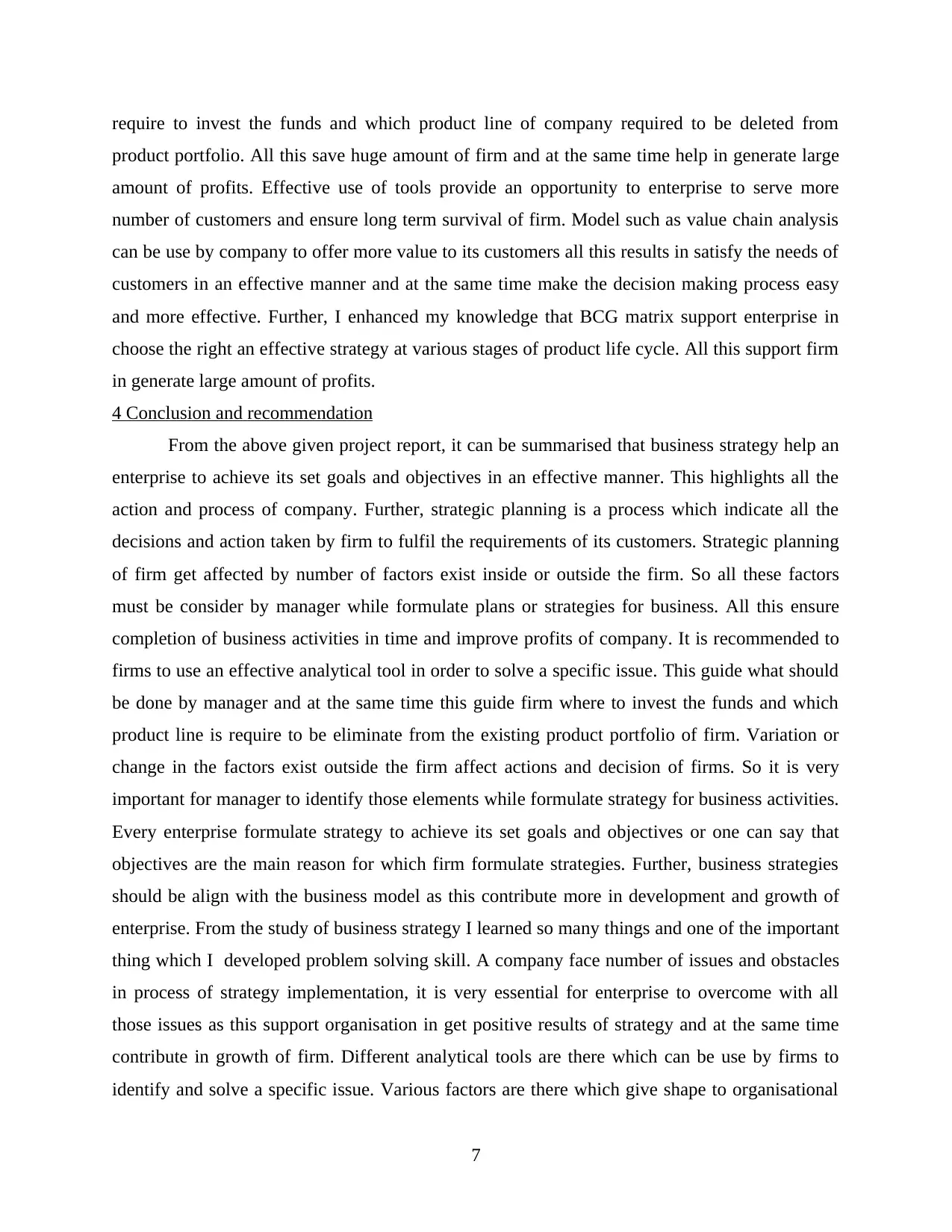
require to invest the funds and which product line of company required to be deleted from
product portfolio. All this save huge amount of firm and at the same time help in generate large
amount of profits. Effective use of tools provide an opportunity to enterprise to serve more
number of customers and ensure long term survival of firm. Model such as value chain analysis
can be use by company to offer more value to its customers all this results in satisfy the needs of
customers in an effective manner and at the same time make the decision making process easy
and more effective. Further, I enhanced my knowledge that BCG matrix support enterprise in
choose the right an effective strategy at various stages of product life cycle. All this support firm
in generate large amount of profits.
4 Conclusion and recommendation
From the above given project report, it can be summarised that business strategy help an
enterprise to achieve its set goals and objectives in an effective manner. This highlights all the
action and process of company. Further, strategic planning is a process which indicate all the
decisions and action taken by firm to fulfil the requirements of its customers. Strategic planning
of firm get affected by number of factors exist inside or outside the firm. So all these factors
must be consider by manager while formulate plans or strategies for business. All this ensure
completion of business activities in time and improve profits of company. It is recommended to
firms to use an effective analytical tool in order to solve a specific issue. This guide what should
be done by manager and at the same time this guide firm where to invest the funds and which
product line is require to be eliminate from the existing product portfolio of firm. Variation or
change in the factors exist outside the firm affect actions and decision of firms. So it is very
important for manager to identify those elements while formulate strategy for business activities.
Every enterprise formulate strategy to achieve its set goals and objectives or one can say that
objectives are the main reason for which firm formulate strategies. Further, business strategies
should be align with the business model as this contribute more in development and growth of
enterprise. From the study of business strategy I learned so many things and one of the important
thing which I developed problem solving skill. A company face number of issues and obstacles
in process of strategy implementation, it is very essential for enterprise to overcome with all
those issues as this support organisation in get positive results of strategy and at the same time
contribute in growth of firm. Different analytical tools are there which can be use by firms to
identify and solve a specific issue. Various factors are there which give shape to organisational
7
product portfolio. All this save huge amount of firm and at the same time help in generate large
amount of profits. Effective use of tools provide an opportunity to enterprise to serve more
number of customers and ensure long term survival of firm. Model such as value chain analysis
can be use by company to offer more value to its customers all this results in satisfy the needs of
customers in an effective manner and at the same time make the decision making process easy
and more effective. Further, I enhanced my knowledge that BCG matrix support enterprise in
choose the right an effective strategy at various stages of product life cycle. All this support firm
in generate large amount of profits.
4 Conclusion and recommendation
From the above given project report, it can be summarised that business strategy help an
enterprise to achieve its set goals and objectives in an effective manner. This highlights all the
action and process of company. Further, strategic planning is a process which indicate all the
decisions and action taken by firm to fulfil the requirements of its customers. Strategic planning
of firm get affected by number of factors exist inside or outside the firm. So all these factors
must be consider by manager while formulate plans or strategies for business. All this ensure
completion of business activities in time and improve profits of company. It is recommended to
firms to use an effective analytical tool in order to solve a specific issue. This guide what should
be done by manager and at the same time this guide firm where to invest the funds and which
product line is require to be eliminate from the existing product portfolio of firm. Variation or
change in the factors exist outside the firm affect actions and decision of firms. So it is very
important for manager to identify those elements while formulate strategy for business activities.
Every enterprise formulate strategy to achieve its set goals and objectives or one can say that
objectives are the main reason for which firm formulate strategies. Further, business strategies
should be align with the business model as this contribute more in development and growth of
enterprise. From the study of business strategy I learned so many things and one of the important
thing which I developed problem solving skill. A company face number of issues and obstacles
in process of strategy implementation, it is very essential for enterprise to overcome with all
those issues as this support organisation in get positive results of strategy and at the same time
contribute in growth of firm. Different analytical tools are there which can be use by firms to
identify and solve a specific issue. Various factors are there which give shape to organisational
7
⊘ This is a preview!⊘
Do you want full access?
Subscribe today to unlock all pages.

Trusted by 1+ million students worldwide
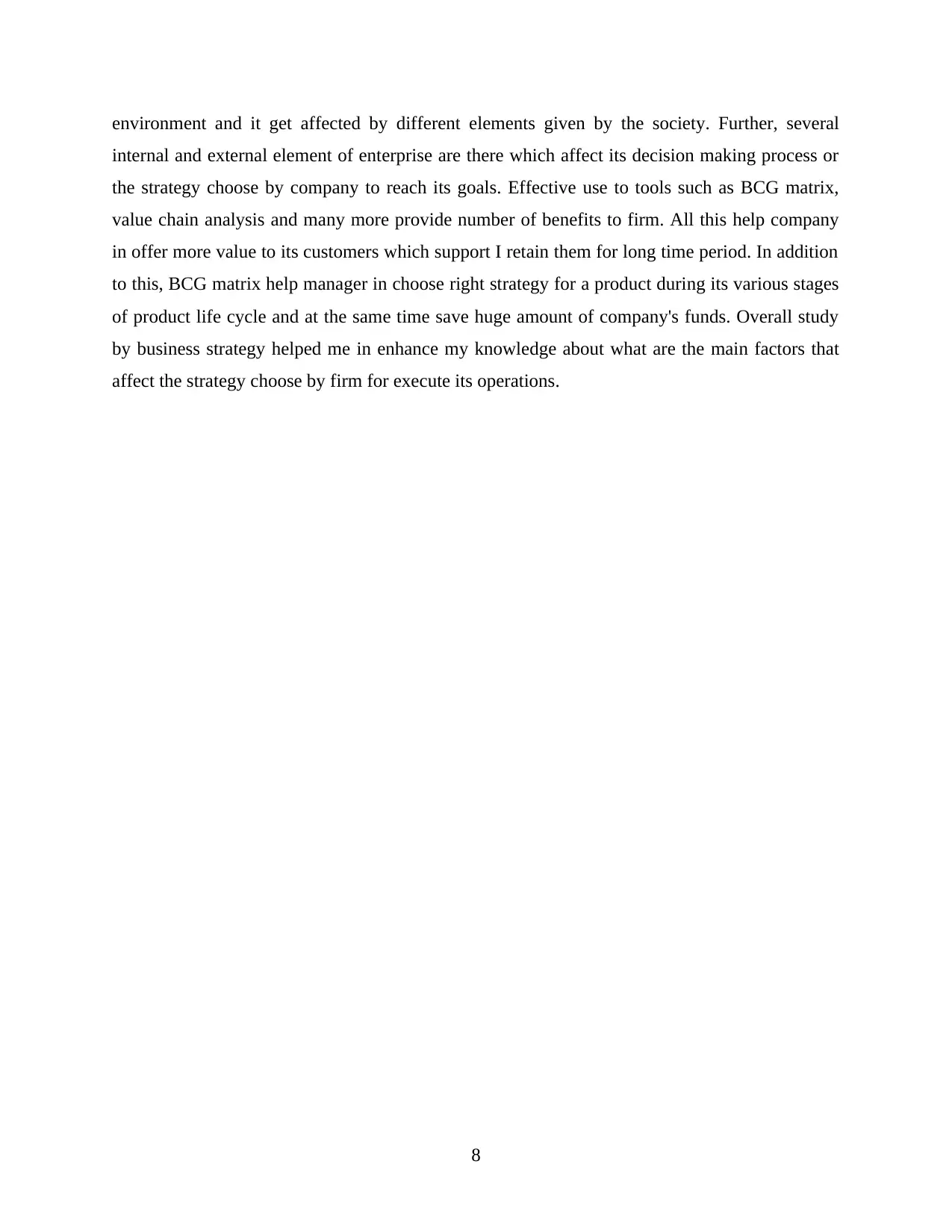
environment and it get affected by different elements given by the society. Further, several
internal and external element of enterprise are there which affect its decision making process or
the strategy choose by company to reach its goals. Effective use to tools such as BCG matrix,
value chain analysis and many more provide number of benefits to firm. All this help company
in offer more value to its customers which support I retain them for long time period. In addition
to this, BCG matrix help manager in choose right strategy for a product during its various stages
of product life cycle and at the same time save huge amount of company's funds. Overall study
by business strategy helped me in enhance my knowledge about what are the main factors that
affect the strategy choose by firm for execute its operations.
8
internal and external element of enterprise are there which affect its decision making process or
the strategy choose by company to reach its goals. Effective use to tools such as BCG matrix,
value chain analysis and many more provide number of benefits to firm. All this help company
in offer more value to its customers which support I retain them for long time period. In addition
to this, BCG matrix help manager in choose right strategy for a product during its various stages
of product life cycle and at the same time save huge amount of company's funds. Overall study
by business strategy helped me in enhance my knowledge about what are the main factors that
affect the strategy choose by firm for execute its operations.
8
Paraphrase This Document
Need a fresh take? Get an instant paraphrase of this document with our AI Paraphraser
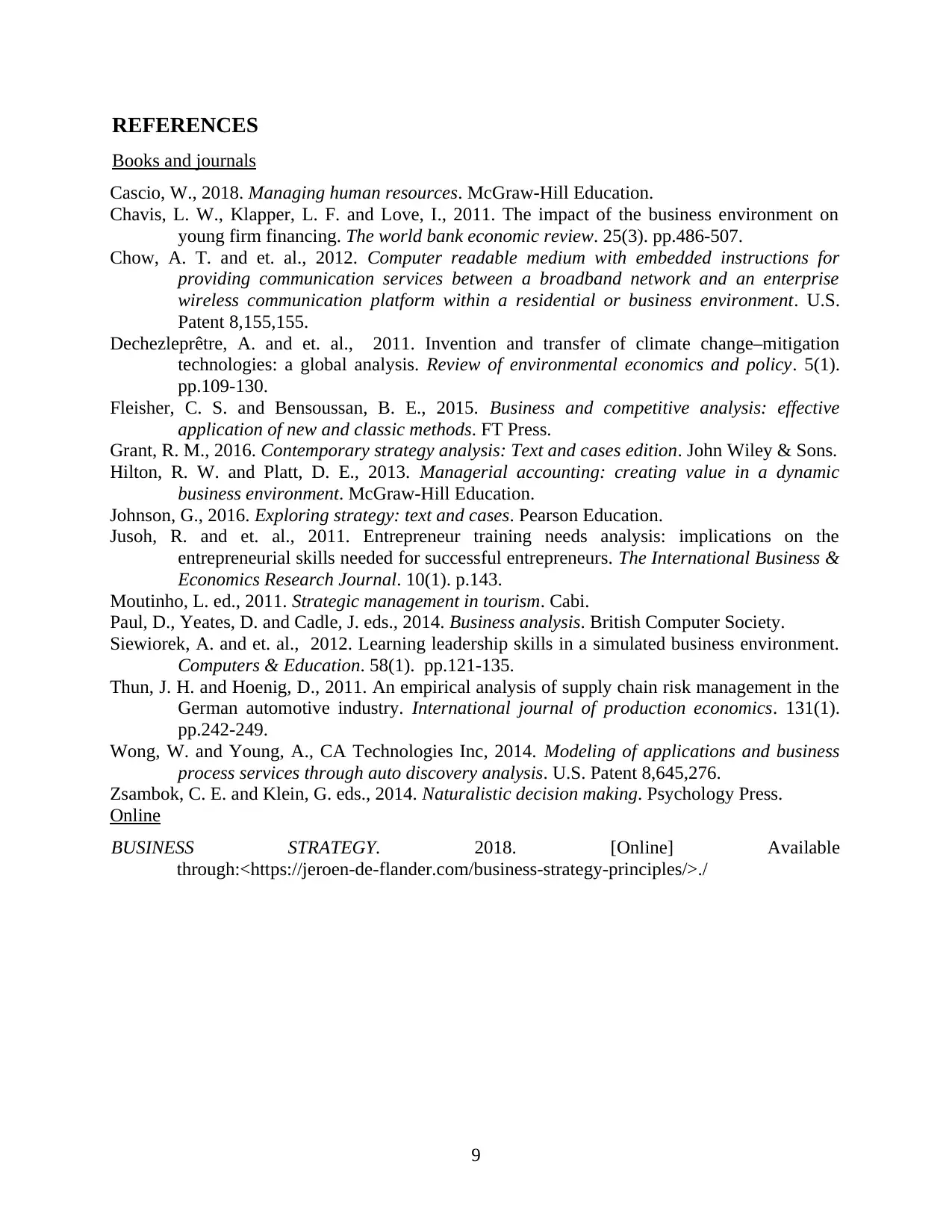
REFERENCES
Books and journals
Cascio, W., 2018. Managing human resources. McGraw-Hill Education.
Chavis, L. W., Klapper, L. F. and Love, I., 2011. The impact of the business environment on
young firm financing. The world bank economic review. 25(3). pp.486-507.
Chow, A. T. and et. al., 2012. Computer readable medium with embedded instructions for
providing communication services between a broadband network and an enterprise
wireless communication platform within a residential or business environment. U.S.
Patent 8,155,155.
Dechezleprêtre, A. and et. al., 2011. Invention and transfer of climate change–mitigation
technologies: a global analysis. Review of environmental economics and policy. 5(1).
pp.109-130.
Fleisher, C. S. and Bensoussan, B. E., 2015. Business and competitive analysis: effective
application of new and classic methods. FT Press.
Grant, R. M., 2016. Contemporary strategy analysis: Text and cases edition. John Wiley & Sons.
Hilton, R. W. and Platt, D. E., 2013. Managerial accounting: creating value in a dynamic
business environment. McGraw-Hill Education.
Johnson, G., 2016. Exploring strategy: text and cases. Pearson Education.
Jusoh, R. and et. al., 2011. Entrepreneur training needs analysis: implications on the
entrepreneurial skills needed for successful entrepreneurs. The International Business &
Economics Research Journal. 10(1). p.143.
Moutinho, L. ed., 2011. Strategic management in tourism. Cabi.
Paul, D., Yeates, D. and Cadle, J. eds., 2014. Business analysis. British Computer Society.
Siewiorek, A. and et. al., 2012. Learning leadership skills in a simulated business environment.
Computers & Education. 58(1). pp.121-135.
Thun, J. H. and Hoenig, D., 2011. An empirical analysis of supply chain risk management in the
German automotive industry. International journal of production economics. 131(1).
pp.242-249.
Wong, W. and Young, A., CA Technologies Inc, 2014. Modeling of applications and business
process services through auto discovery analysis. U.S. Patent 8,645,276.
Zsambok, C. E. and Klein, G. eds., 2014. Naturalistic decision making. Psychology Press.
Online
BUSINESS STRATEGY. 2018. [Online] Available
through:<https://jeroen-de-flander.com/business-strategy-principles/>./
9
Books and journals
Cascio, W., 2018. Managing human resources. McGraw-Hill Education.
Chavis, L. W., Klapper, L. F. and Love, I., 2011. The impact of the business environment on
young firm financing. The world bank economic review. 25(3). pp.486-507.
Chow, A. T. and et. al., 2012. Computer readable medium with embedded instructions for
providing communication services between a broadband network and an enterprise
wireless communication platform within a residential or business environment. U.S.
Patent 8,155,155.
Dechezleprêtre, A. and et. al., 2011. Invention and transfer of climate change–mitigation
technologies: a global analysis. Review of environmental economics and policy. 5(1).
pp.109-130.
Fleisher, C. S. and Bensoussan, B. E., 2015. Business and competitive analysis: effective
application of new and classic methods. FT Press.
Grant, R. M., 2016. Contemporary strategy analysis: Text and cases edition. John Wiley & Sons.
Hilton, R. W. and Platt, D. E., 2013. Managerial accounting: creating value in a dynamic
business environment. McGraw-Hill Education.
Johnson, G., 2016. Exploring strategy: text and cases. Pearson Education.
Jusoh, R. and et. al., 2011. Entrepreneur training needs analysis: implications on the
entrepreneurial skills needed for successful entrepreneurs. The International Business &
Economics Research Journal. 10(1). p.143.
Moutinho, L. ed., 2011. Strategic management in tourism. Cabi.
Paul, D., Yeates, D. and Cadle, J. eds., 2014. Business analysis. British Computer Society.
Siewiorek, A. and et. al., 2012. Learning leadership skills in a simulated business environment.
Computers & Education. 58(1). pp.121-135.
Thun, J. H. and Hoenig, D., 2011. An empirical analysis of supply chain risk management in the
German automotive industry. International journal of production economics. 131(1).
pp.242-249.
Wong, W. and Young, A., CA Technologies Inc, 2014. Modeling of applications and business
process services through auto discovery analysis. U.S. Patent 8,645,276.
Zsambok, C. E. and Klein, G. eds., 2014. Naturalistic decision making. Psychology Press.
Online
BUSINESS STRATEGY. 2018. [Online] Available
through:<https://jeroen-de-flander.com/business-strategy-principles/>./
9
1 out of 11
Related Documents
Your All-in-One AI-Powered Toolkit for Academic Success.
+13062052269
info@desklib.com
Available 24*7 on WhatsApp / Email
![[object Object]](/_next/static/media/star-bottom.7253800d.svg)
Unlock your academic potential
Copyright © 2020–2025 A2Z Services. All Rights Reserved. Developed and managed by ZUCOL.





